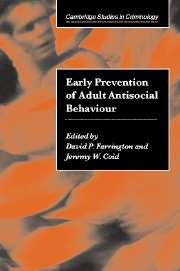Book contents
- Frontmatter
- Contents
- List of figures
- List of tables
- List of contributors
- Preface
- 1 Advancing knowledge about the early prevention of adult antisocial behaviour
- 2 Formulating strategies for the primary prevention of adult antisocial behaviour: “High risk” or ‘population’ strategies?
- 3 Risk factors for adult antisocial personality
- 4 Preventing the intergenerational continuity of antisocial behaviour: Implications of partner violence
- 5 Protective factors and resilience
- 6 Prevention during pregnancy, infancy and the preschool years
- 7 Prevention through family and parenting programmes
- 8 Prevention in the school years
- 9 Prevention of antisocial behaviour in females
- 10 Economic costs and benefits of primary prevention of delinquency and later offending: A review of the research
- 11 Conclusions and the way forward
- Index
- References
2 - Formulating strategies for the primary prevention of adult antisocial behaviour: “High risk” or ‘population’ strategies?
Published online by Cambridge University Press: 22 September 2009
- Frontmatter
- Contents
- List of figures
- List of tables
- List of contributors
- Preface
- 1 Advancing knowledge about the early prevention of adult antisocial behaviour
- 2 Formulating strategies for the primary prevention of adult antisocial behaviour: “High risk” or ‘population’ strategies?
- 3 Risk factors for adult antisocial personality
- 4 Preventing the intergenerational continuity of antisocial behaviour: Implications of partner violence
- 5 Protective factors and resilience
- 6 Prevention during pregnancy, infancy and the preschool years
- 7 Prevention through family and parenting programmes
- 8 Prevention in the school years
- 9 Prevention of antisocial behaviour in females
- 10 Economic costs and benefits of primary prevention of delinquency and later offending: A review of the research
- 11 Conclusions and the way forward
- Index
- References
Summary
Recognition that primary prevention is a key issue in criminology has been a relatively new development in the United Kingdom. There have been few large scale intervention strategies with children specifically aimed at preventing the early manifestation of delinquent behaviour, the transition between different phases of criminality over the lifespan, or the development of adult antisocial syndromes. Higher priority has been accorded in other countries, particularly in North America. However, the various approaches that have been taken elsewhere do not always fit within an overall theoretical approach or coherent strategy. This does not mean that researchers should be obliged to rigidly conform to a single approach, but it would be more helpful if those who intend to develop the area were able to plan their work within the context of some pre-existing theory, or series of theories, of prevention.
Preventive medicine has much to contribute to this research agenda through its theoretical approach to the prevention of disease. This comes about first through its foundations within the academic discipline of epidemiology, and second through the clinical involvement of the professional subdiscipline of Public Health which has traditionally been responsible for the prevention of outbreaks of disease. Theoretical approaches to Preventive Medicine are heavily influenced by the work of the late Geoffrey Rose, former Professor of Epidemiology at the London School of Hygiene and Tropical Medicine.
- Type
- Chapter
- Information
- Early Prevention of Adult Antisocial Behaviour , pp. 32 - 78Publisher: Cambridge University PressPrint publication year: 2003
References
- 20
- Cited by



